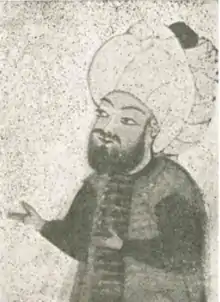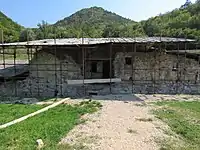Mahmud Pasha Angelović
Mahmud Pasha Angelović (Serbian: Махмуд-паша Анђеловић/Mahmud-paša Anđelović; Turkish: Veli Mahmud Paşa; 1420–1474) was the Grand Vizier of the Ottoman Empire from 1456 to 1466 and again from 1472 to 1474, who also wrote Persian and Turkish poems under the pseudonym Adni (the "Eden-like").[1]
Mahmud Angelović | |
|---|---|
 | |
| 13th Grand Vizier of the Ottoman Empire | |
| In office 1472–1474 | |
| Monarch | Mehmed II |
| Preceded by | Ishak Pasha |
| Succeeded by | Gedik Ahmed Pasha |
| In office 1456–1466 | |
| Monarch | Mehmed II |
| Preceded by | Zaganos Pasha |
| Succeeded by | Rum Mehmed Pasha |
| Personal details | |
| Born | 1420 Novo Brdo, Serbian Despotate (modern-day Kosovo) |
| Died | 1474 (aged 53–54) |
| Nationality | Ottoman |
| Spouse(s) | Selçuk Hatun |
| Military service | |
| Nickname(s) | Adni |
| Allegiance | |
| Branch/service | |
| Rank | Kapudan Pasha (grand admiral) |
| Battles/wars | Siege of Belgrade (1456) Siege of Trebizond (1461) Ottoman conquest of Bosnia |
Born in Kosovo, he was a descendant of the Byzantine Angelos family that had left Thessaly in 1394. As a child, he was given to the Ottomans according to the devşirme system and raised as a Muslim in Edirne. A capable soldier, he was married to a daughter of Sultan Mehmed II. After distinguishing himself at the Siege of Belgrade (1456), he was raised to the position of Grand Vizier as a reward, succeeding Zaganos Pasha. Throughout his tenure, he led armies or accompanied Mehmed II on his own campaigns.
Origin and early life
After the Ottoman conquest of Thessaly in 1394, the ruling Angeloi[2][3] Philanthropenoi family took refuge. The grandchildren of either Alexios or Manuel were Mahmud Pasha and his brother Mihailo Anđelović. He was partially Albanian and related to the Albanian noblemen Alessio and Peter Spani through Alexios III Angelos, who was possibly their ancestor[4] Although the contemporary Byzantine sources and Ibn Kemal calls him Serbian, some late Ottoman sources call him Croatian or Albanian.[b]
It is estimated that Angelović was born in the early 1420s.[5] Most historians accept that Angelović was born in Novo Brdo in the Serbian Despotate, and that his father Mihailos was the son of either Alexios Angelos Philanthropenos or his son/nephew/brother Manuel, rulers of Thessaly.[6] T. Stavrides views it more probable that Manuel was his grandfather.[5] The only information on his father is that he lived in Serbia in the 1420s.[5] His mother's ancestry is the matter of debate. Chalkokondyles (1430–1470) called her Serbian, Kritoboulos (1410–1470), Greek, while there are various theories on her noble ancestry.[7] Angelović had a brother, Mihailo Anđelović, later a prominent Serbian statesman.[8]
According to Tahsin Yazici / Encyclopædia Iranica, Angelović was "born to a Greek or Serbian family".[9]
Chalkokondyles mentions that Angelović was captured by Ottoman horsemen while traveling with his mother from Novo Brdo to Smederevo (the Serbian capital), and taken to the Ottoman court.[10] It is assumed that this took place in 1427, when the Ottomans attacked Serbia.[11] Furthermore, it is unconcluded whether he was captured according to the devşirme(practice, the regular practice of taking children certain noble families whose Ottomans have taken lands and making these children high rankings officials) or as a prisoner of war.[12] Taşköprüzade (d. 1560) and Aşık Çelebi (1520–1572) name two other boys led with Angelović on horseback to Edirne, Molla Iyas and Mevlana Abdülkerim, the latter which reached the rank of kadıasker (chief judge) and şeyhülislam (Islamic scholar).[13] Upon conversion to Islam, he received the name Mahmud.
Little is known about his activities before 1453. According to T. Stavrides, Angelović and his companions were educated in the palace, probably as içoğlan, and Mahmud then entered service in the Enderûn, later serving prince Mehmed, the future sultan.[14] Sources do not agree on which posts he held at the palace.[15]
Life

Mahmud Pasha was a capable soldier. After distinguishing himself at the Siege of Belgrade (1456), he was raised to the position of Grand Vizier as a reward, succeeding Zaganos Pasha.[16] Throughout his tenure he led armies or accompanied Mehmed II on his own campaigns.[17]
In 1458, the Serbian Despot Lazar Branković died. Mahmud's brother Mihailo became member of a collective regency, but he was soon deposed by the anti-Ottoman and pro-Hungarian faction in the Serbian court. In reaction, Mahmud attacked and seized Smederevo Fortress, although the citadel held out, and seized some additional strongholds in its vicinity. Threatened by a possible Hungarian intervention however he was forced to withdraw south and join the forces of Sultan Mehmed II at Skopje.[18] In 1461, he accompanied Mehmed in his campaign against the Empire of Trebizond, the last surviving fragment of the Byzantine Empire. Mahmud negotiated the surrender of the city of Trebizond with the protovestiarios, the scholar George Amiroutzes, who was also his cousin.[19]
In 1463, Mahmud led the invasion and conquest of the Kingdom of Bosnia, even though a peace treaty between Bosnia and the Ottomans had just been renewed. He captured the Bosnian king, Stephen Tomašević, at Ključ, and obtained from him the cession of the country to the Empire.[18]
Angelović accompanied Mehmed II when he attacked Albania Veneta in the summer of 1467, and ravaged the lands. For 15 days he pursued Skanderbeg, who was a Venetian ally at the time, but failed to find him, as Skanderbeg retreated into the mountains and then succeeded in fleeing to the coast.[20] According to Tursun Beg and Ibn Kemal, Angelović swam over Bojana, attacked Venetian-controlled Scutari, and plundered the surrounding area.[21]
Mahmud was dismissed in 1468 due to the machinations of his successor, Rum Mehmed Pasha, ostensibly due to irregularities regarding the resettlement of the Karamanids in Constantinople following the conquest of Karaman earlier in that year.[22] He was reinstated in 1472, but his relations with the Sultan were now strained. He was dismissed and executed in 1474, allegedly because of Mehmed's son, prince Mustafa. Mahmud had been at loggerheads with Mustafa after divorcing his second wife for spending a night in the same house as Mustafa during Mahmud's absence on campaign in 1473. Mustafa's death later in 1474 was even attributed by later accounts to poisoning by Mahmud.[23]
Literary output
Mahmud Pasha wrote works in Persian and Turkish with "Adni" as his nom de plume.[9] The divan he composed includes 45 ghazals and 21 mofrads in Persian, as well as "some rather successful naziras on the ghazals of Zahir Faryabi and Hafez".[9] Tahsin Yazici / Encyclopædia Iranica adds that Mahmud Pasha "also wrote a number of official letters in Persian".[9]
Family
He married Selçuk Hatun, daughter of Zaganos Pasha, by his wife Sitti Nefise Hatun, and had a son named Ali Bey and a daughter named Hatice Hatun.
References
- Stavrides 2001, p. 311.
- Stavrides 2001, p. 311 "Mahmud Pasha's Pseudonym According to all indications, the pseudonym (mahlas) used by Mahmud Pasha when writing poetry was Adni (the Eden-like) and this is indicated by most sources, most particularly Asik Celebi and Sehi Beg, who ..."
- Babinger 1992, p. 476 "With the possible exception of the grand vizier Mahmud Pasha, who under the pseudonym of Adni wrote Persian and Ottoman Turkish rhymes, the period offers no further poets of above-average quality. Among the poets it seems fitting to mention as ..."
- Stavrides 2001, p. 228.
- Stavrides 2001, p. 77.
- Stavrides 2001, pp. 73–74, 76–77.
- Stavrides 2001, pp. 78–93.
- Stavrides 2001, pp. 93–100.
- Yazici 1983, p. 470.
- Stavrides 2001, p. 107.
- Stavrides 2001, p. 108.
- Stavrides 2001, p. 108–110.
- Stavrides 2001, pp. 108–109.
- Stavrides 2001, p. 110.
- Stavrides 2001, p. 111–112.
- Finkel 2006, p. 78
- Finkel 2006, pp. 78–79, 559, 560.
- Finkel 2006, p. 60.
- Finkel 2006, p. 62
- Stavrides 2001, pp. 163, 164.
- Stavrides 2001, p. 164.
- Finkel 2006, pp. 78–79.
- Finkel 2006, p. 79
Sources
- Babinger, Franz (1992). Mehmed the Conqueror and His Time. Bollingen Series 96. Translated from the German by Ralph Manheim. Edited, with a preface, by William C. Hickman. Princeton, New Jersey: Princeton University Press. ISBN 0-691-09900-6. OCLC 716361786.
- Finkel, Caroline (2006). Osman's Dream: The Story of the Ottoman Empire 1300–1923. London: John Murray. ISBN 978-0-7195-6112-2.
- Stavrides, Théoharis (2001). The Sultan of Vezirs: The Life and Times of the Ottoman Grand Vezir Mahmud Pasha Angelovic (1453–1474). Brill. ISBN 978-90-04-12106-5.
- Tekindağ, Şehabeddin (2003). "Mahmud Paşa" (PDF). İslâm Ansiklopedisi, Vol. 27 (Kütahya Mevlevihânesi – Manisa) (in Turkish). pp. 376–378.
- Yazici, T. (1983). "ʿADNĪ, MAḤMŪD PĀŠĀ". Encyclopaedia Iranica, Vol. I, Fasc. 5. p. 470.
| Political offices | ||
|---|---|---|
| Preceded by Zaganos Pasha |
Grand Vizier of the Ottoman Empire 1456–1466 |
Succeeded by Rum Mehmed Pasha |
| Preceded by Ishak Pasha |
Grand Vizier of the Ottoman Empire 1472–1474 |
Succeeded by Gedik Ahmed Pasha |
.svg.png.webp)